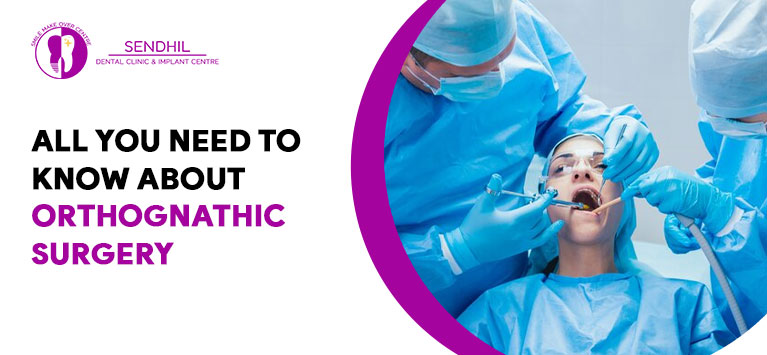
All you need to know about Orthognathic Surgery
Orthognathic surgery allows you to resolve cases of facial disharmony, both for functional and aesthetic reasons. The goal of these interventions is to move the jaw to a more suitable and functional position through the combination of orthodontics (which moves the teeth into the ideal position) and maxillofacial surgery (which correctly positions the teeth and bones).
What Is Orthognathic Surgery?
Orthognathic surgery is aimed at patients who need to correct dentofacial complications, more commonly known as dentoskeletal malocclusions, which is referred to when one or more bones of the face (chin, maxilla, mandible) present abnormal growth, causing anomalies in maxillomandibular development in people, thus altering facial harmony.
To understand the heart of this intervention, it is sufficient to clarify the meaning of the word itself, orthognathic, which derives from the Greek “orthos” (rectum) and “gnathos” (jaw). That is a surgery that restores the jaw bones.
In adulthood, “dental braces” alone cannot correct skeletal problems of the face, which is why it is necessary to turn to orthognathic surgery.
Types Of Orthognathic Surgery
Orthognathic surgery must be performed by an oral surgeon, the only specialist to treat both the bones and soft tissues of the facial area. There are some types of orthognathic surgery, namely jaw surgery and maxillomandibular surgery, also called bimaxillary surgery.
Orthognathic Surgery Of The Upper Jaw
Third-class orthognathic surgery of the jaw is performed to position the jaw in the correct position so that it can achieve facial harmony and, above all, a recovery of the functionality of this bone, thus being able to chew, breathe, and speak. This procedure is performed to correct various facial deformities, such as Class 3 jaw or undershot, open bite, or gummy smile.
Orthognathic jaw surgery is a jaw bone cutting called osteotomy, which allows advancement, retrusion, lengthening, shortening, or rotation of the jaw bone. Once the jaw is in the desired position, it is fixed with titanium plates, a completely biocompatible material. This procedure is performed with a minimally invasive approach in approximately 40 minutes of surgical time.
Mandibular Orthognathic Surgery
Due to the risks associated with second-class orthognathic surgery of mandibular recession (narrowing of the airways), the most commonly performed surgery in the jaw is mandibular advancement surgery. This procedure is necessary when people have a jaw that is small and retracted relative to the maxilla, a condition known as retrognathia or class II.
This type of malformation mainly affects the harmony of the lower part of the face and causes various functional problems, such as sleep apnea.
If considering orthognathic surgery, risks must be known, and the surgical mandibular advancement is cut on each side of the maxillary bone called bilateral sagittal osteotomy, an advancement of the same and fixing the bone in the new position using titanium plates, a completely biocompatible. It is a simple procedure that requires an average of 30 minutes of surgical time.
Maxillomandibular Orthognathic Surgery
In most orthognathic surgery patients, it is necessary to reposition the maxilla and mandible to achieve correct occlusion and facial harmony; this procedure is known as maxillomandibular surgery or bimaxillary orthognathic surgery.
Risks in the case of orthognathic surgery may exist, and you should know that the bimaxillary one treats the following defects: Class 2, Class 3, facial asymmetry, or open bite when a single maxillary surgery is not sufficient to solve the patient’s problems. Thanks to the 3D planning system and the minimally invasive approach, a maxillomandibular surgery operation lasts from 90 to 120 minutes, and the patient can return home the day after the operation.
Who Needs Orthognathic Surgery?
Orthognathic surgery is aimed at all subjects who need to correct the position and shape of the jaws. Therefore, it will be necessary in those cases where there are mandibular or maxillary alterations that cause functional and aesthetic problems that cannot be corrected with orthodontics alone.
People who can benefit from this surgery are:
- Patients with bite problems: second-class malocclusion, third-class malocclusion, also called mandibular progenism or prognathism (chin further out than usual), mandibular retrogenia, or retrognathism (the upper jaw is advanced compared to the lower one). Often, the terminology of these pathologies is little known, but there are many easy-to-understand terms to frame the problems treated: excessively pronounced chin, forward chin, protruding jaw, forward or opposite jaw, receding chin, backward chin, chin small, short chin, retruded chin.
- Patients with facial asymmetry: It is an imbalance between the left and right sides of the face. Obviously, there are many types of asymmetry and can also include integration of plastic surgery; however, when the asymmetry is at a dental-skeletal level, surgical and orthodontic treatments will be combined. In current terminology, this problem is recognized by users as asymmetric face, asymmetric face, mandibular asymmetry, crooked face, crooked chin, and asymmetric chin.
- Patients with a gummy smile: People who present a “gummy” smile show a large amount of gum when they smile, causing an optical effect with short teeth compared to the size of the mouth. The surgery is therefore needed when the teeth, gums, and upper jaw are all out of proportion.
What does orthognathic surgery consist of?
The operation lasts from two to four hours and is performed under general anesthesia in a hospital environment.
To act on the maxilla, the mandible, or both, the surgeon makes cuts (osteotomies) and movements of the bones through intraoral incisions that leave no visible scars. Once the jaw bones have been placed in a harmonious position and size, they will be fixed in the new location using mini-plates and titanium screws.
Following the operation, the patient will remain in the clinic for two consecutive nights,
after which he will be discharged. Post-surgery visits will follow with the surgeon and orthodontist to closely monitor the patient’s occlusal evolution. Generally, after surgery, a phase of short orthodontics follows with the aim of maintaining the teeth in the new position acquired with the surgery.
In conclusion
Orthognathic surgery is a transformative solution for individuals with dento-skeletal malocclusions, offering both functional and aesthetic improvements. This procedure, performed by skilled oral surgeons, corrects jaw abnormalities and facial disharmony. Whether it’s addressing bite problems, facial asymmetry, or a gummy smile, orthognathic surgery can restore balance and harmony. With advancements in surgical techniques and minimal invasiveness, it’s a viable option for those seeking lasting results. If you’re considering orthognathic surgery, consult with a specialist to explore your options and achieve the smile and facial balance you desire.



